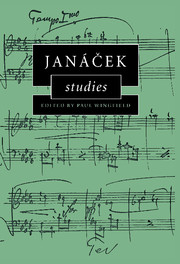Book contents
- Frontmatter
- Contents
- Preface
- 1 Expressive sources and resources in Janáček's musical language
- 2 ‘Nothing but pranks and puns’: Janáček's solo piano music
- 3 Narrative in Janáček's symphonic poems
- 4 Evasive realism: narrative construction in Dostoyevsky's and Janáček's From the House of the Dead
- 5 Direct discourse and speech melody in Janáček's operas
- 6 Kundera's eternal present and Janáček's ancient Gypsy
- 7 Janáček's folk settings and the Vixen
- 8 Janáček's operas in Australia and New Zealand: a performance history
- 9 Janáček's Moravian publishers
- 10 Janáček, musical analysis, and Debussy's ‘Jeux de vagues’
- Index
1 - Expressive sources and resources in Janáček's musical language
Published online by Cambridge University Press: 22 September 2009
- Frontmatter
- Contents
- Preface
- 1 Expressive sources and resources in Janáček's musical language
- 2 ‘Nothing but pranks and puns’: Janáček's solo piano music
- 3 Narrative in Janáček's symphonic poems
- 4 Evasive realism: narrative construction in Dostoyevsky's and Janáček's From the House of the Dead
- 5 Direct discourse and speech melody in Janáček's operas
- 6 Kundera's eternal present and Janáček's ancient Gypsy
- 7 Janáček's folk settings and the Vixen
- 8 Janáček's operas in Australia and New Zealand: a performance history
- 9 Janáček's Moravian publishers
- 10 Janáček, musical analysis, and Debussy's ‘Jeux de vagues’
- Index
Summary
Broadly speaking either composers want primarily to make shapes, patterns, forms, journeys, buildings, tables, gardens, mud-pies, or they want primarily to utter what wells up from within themselves, or from what is suggested within themselves by the impact of things from around them. If Haydn is the ultimate instance of the ‘pure’ composer writing ‘music about music’ (though manifestly not deficient in humanity), Janáček can surely be seen as the ultimate composer of Affekt in whom music becomes the medium for expression so immediate as to transcend the linguistic metaphor to become in itself the thing that feels and moves.
Suppose, when traversing the back routes of his loved and hated native land by coach or train a vast pang of inarticulate emotion swells up around the composer's heart – ‘my country’; suppose, thinking of his parents, his earliest memories, impressions, motivations, sensations, thoughts – ‘my childhood’; suppose, reliving the deepest, tenderest, most painful intimacies, their mixture of harsh and delicate, tender and cruel, guilty and carefree, blighted and flowering, dampened and burning – ‘my life’; suppose, then, the composer would seek to ‘express’ these feelings, to capture the unutterable, as music purportedly can, in a chord-sequence, in a turn of phrase, a rhythmic gesture, a timbral combination, how would he do so? What chords, intervals, rhythms, timbres?
- Type
- Chapter
- Information
- Janácek Studies , pp. 1 - 17Publisher: Cambridge University PressPrint publication year: 1999



